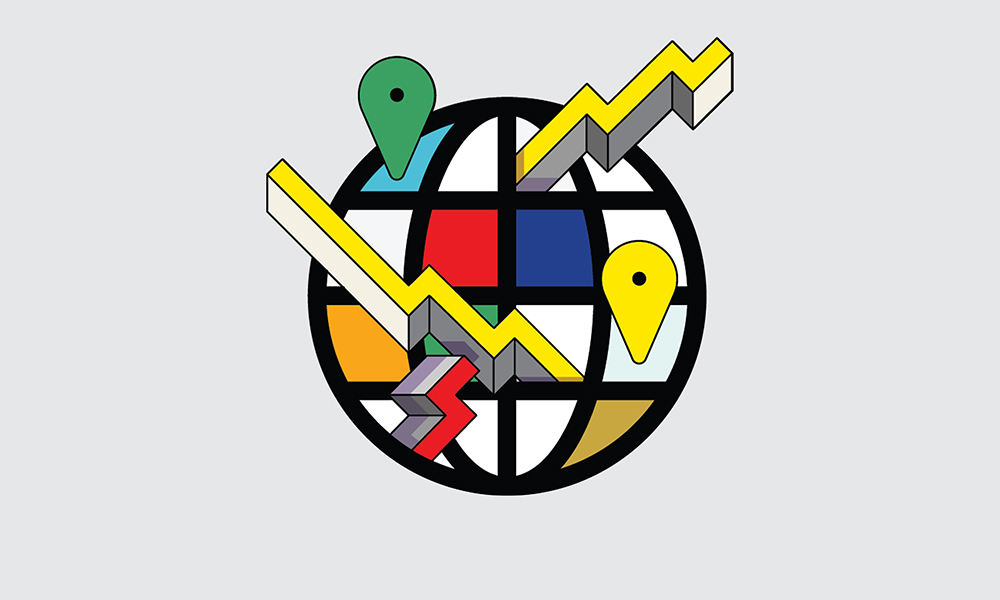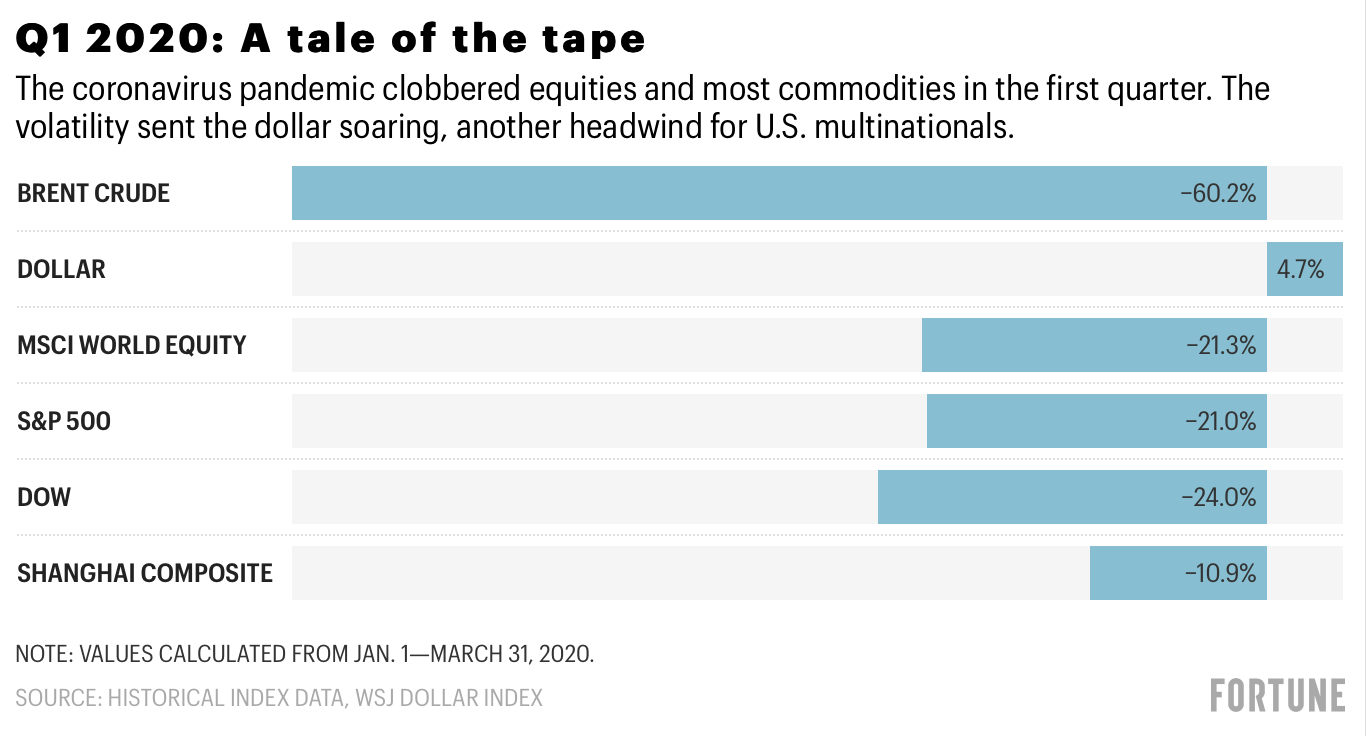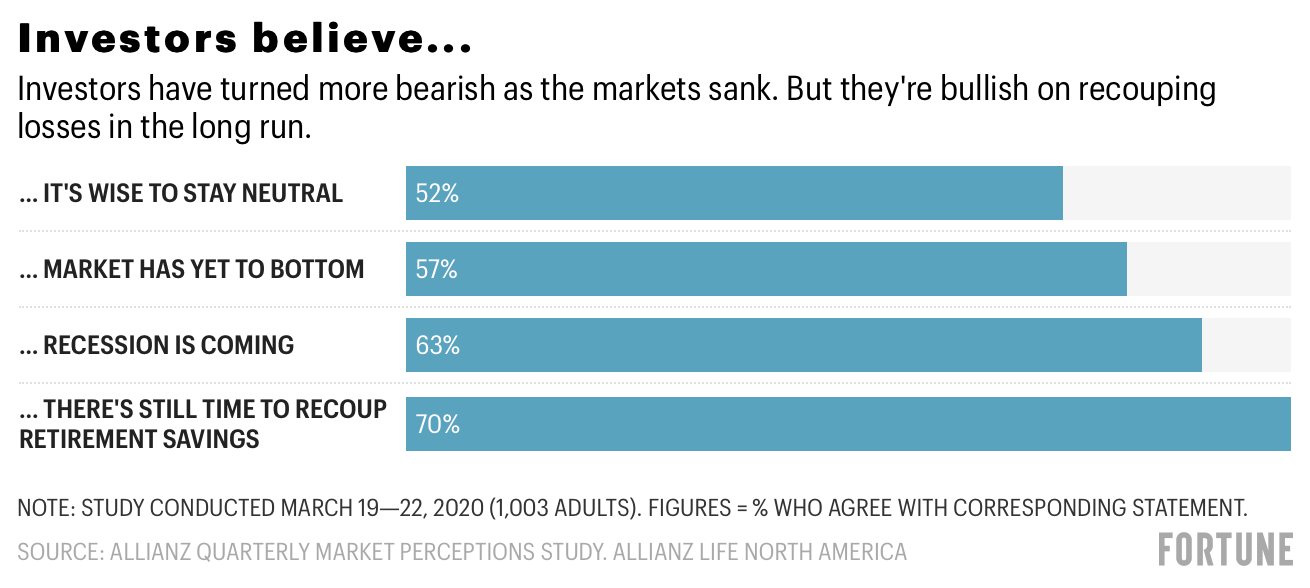 插圖:JAMIE CULLEN
插圖:JAMIE CULLEN你正坐在沙發上看新聞。全是令人沮喪的消息。新冠肺炎感染者數量持續攀升,股市繼續暴跌。你拿起手機看了看自己買的股票。唉!全在下跌!怎么辦?
賣掉?
勇敢點,進場抄底?
繼續持有?
每一種做法都可以看作是一種策略,但卻很難讓人感到安慰。
我們剛剛經歷了史上最糟糕的第一季度。那是道瓊斯指數自1987年以來表現最差的一個季度。1987年正是發生臭名昭著的“黑色星期一”股災的那一年。標普500指數的糟糕表現,只有2008年金融危機最嚴重的時候才能與之“相媲美”。
而且不止是股市。大宗商品市場也難以幸免。由于全球出行禁令、工廠停工和全球勞動者居家隔離,原油價格下跌了60%。由于難以想象的零息債券成為可能,導致美國10年期國債收益率暴跌122個基點,這表明投資者陷入極度恐慌。市場在最糟糕的時候所要表達的信息已經很清楚:零回報總好過賠錢。
 圖:2020年1季度,布倫特原油、美元、摩根士丹利資本國際全球股票指數、標準普爾500指數、道瓊斯指數、上證綜指的浮動情況。
圖:2020年1季度,布倫特原油、美元、摩根士丹利資本國際全球股票指數、標準普爾500指數、道瓊斯指數、上證綜指的浮動情況。工廠停工和停止出行等舉措,最大程度抑制了疫情傳播,但卻讓原油期貨和全球股市在第一季度大幅下跌。
但現在有一些好消息。雖然標普500指數在第一季度下跌了21%(見上圖),但看看該指數在過去兩周的表現你會有截然不同的發現。從3月23日收盤至4月6日收盤,標普500指數上漲了19%。真希望你聽到了腦海中那個告訴你“勇敢點”的聲音。
但在震蕩行情中,事后評價自己的行為沒有任何意義。即使專業人士也會犯錯。更重要的是,99.99%的投資者并不是專業人士。所以不要自責了!
紐約大學斯特恩商學院的經濟學教授尼古拉斯·伊科諾米季斯表示:“在金融市場,多數人并沒有足夠的專業知識。這并非他們的本職工作。”而且一場百年不遇的大疫情導致全球股市暴跌,很快你就會看到那些毫無經驗的401(k)計劃投資者在股市的浪潮中苦苦掙扎。
伊科諾米季斯有哪些建議?他表示,在當前的市場環境下,不要與鯊魚一起游泳。等到風平浪靜之后再下水:“為什么要觀望?如果你沒有專業知識,現在的任何動作可能讓你全盤皆輸,這是愚蠢的行為。”
每個投資者都有各自不同的風險狀況。有的投資者有條件嘗試預測反彈的時間,從而讓自己的獲利最大化。但有的投資者必須等到市場穩定在一定區間之后,再去計劃下一步。
事實上,專家認為,不要嘗試預測“反彈”或“上漲”的時間,更明智的做法是預測市場“平靜”的時間,即從每日暴漲變成幅度較小但循序漸進的波動。
比如:多數市場觀察員依舊在嘗試預測市場低點,而不是它會漲到多高。因此,摩根大通分析師最近指出,波動性成為他們日益重要的一個指標。分析師們最近專門研究了芝加哥期權交易所波動率指數,并將該指數與新冠肺炎感染人數和死亡人數相匹配。他們通過微積分運算得出標普500指數的最低點在2,100點左右(標普500指數在3月份第三周跌至2,193點,最接近這一水平,但之后開始反彈)。
我知道你在想什么。2100點?現在比2100點高出了20%以上。我們還會下跌到那個水平嗎?
請記住:熊市的平均跌幅為32.7%。在所有熊市中下跌幅度最大的是上一次,即從2007年至2009年全球金融危機最嚴重的時期。這一次,標普指數從最高點至最低點的跌幅為34.1%;但從3月23日跌至最低點至今,標普指數已經收復了超過一半失地。
第二季度會帶來什么?
第一季度出現了各種極端行情。標普500指數在2月份漲至歷史新高,不到兩周后就跌入了回調區間。但最終它卻以強勁的表現結束了第一季度。目前還有許多問題值得擔憂,比如創紀錄的失業率、全球經濟衰退以及距離結束遙遙無期的全球致命疫情。
現在的市場并不適合追求短期回報。但從長遠來看,市場依舊會強勢上揚。
安聯人壽高級市場副總裁凱利·拉維尼表示:“過去幾周,美國投資者眼看著他們的投資和退休儲蓄大幅縮水,他們或許會想是否應該采取行動止血。好消息是對于多數人而言,還是理智占了上風,許多人似乎清楚,他們必須有長遠眼光,盡量渡過難關。”
最新一期安聯季度市場認知研究詢問了投資者對未來的態度。結果顯示,并不是所有人都是悲觀的心態。大部分(63%)受訪者表示他們擔心經濟衰退,超過一半(52%)受訪者表示他們現在非常焦慮,不敢繼續投資。
 圖:3月19-22日進行的調查發現,52%的受訪者認為應按兵不動,57%認為市場還未見底,63%認為衰退正在來臨,70%認為有時間重新增加他們的退休儲蓄金。
圖:3月19-22日進行的調查發現,52%的受訪者認為應按兵不動,57%認為市場還未見底,63%認為衰退正在來臨,70%認為有時間重新增加他們的退休儲蓄金。但從整體來看,投資者的情緒更為樂觀。報告稱:“接近70%的投資者認為,即使市場繼續下跌,他們也有時間重新增加他們的退休儲蓄金。”
大部分投資者可以帶著這種情緒堅持下去。(財富中文網)
譯者:BIZ
你正坐在沙發上看新聞。全是令人沮喪的消息。新冠肺炎感染者數量持續攀升,股市繼續暴跌。你拿起手機看了看自己買的股票。唉!全在下跌!怎么辦?
賣掉?
勇敢點,進場抄底?
繼續持有?
每一種做法都可以看作是一種策略,但卻很難讓人感到安慰。
我們剛剛經歷了史上最糟糕的第一季度。那是道瓊斯指數自1987年以來表現最差的一個季度。1987年正是發生臭名昭著的“黑色星期一”股災的那一年。標普500指數的糟糕表現,只有2008年金融危機最嚴重的時候才能與之“相媲美”。
而且不止是股市。大宗商品市場也難以幸免。由于全球出行禁令、工廠停工和全球勞動者居家隔離,原油價格下跌了60%。由于難以想象的零息債券成為可能,導致美國10年期國債收益率暴跌122個基點,這表明投資者陷入極度恐慌。市場在最糟糕的時候所要表達的信息已經很清楚:零回報總好過賠錢。
工廠停工和停止出行等舉措,最大程度抑制了疫情傳播,但卻讓原油期貨和全球股市在第一季度大幅下跌。
但現在有一些好消息。雖然標普500指數在第一季度下跌了21%(見上圖),但看看該指數在過去兩周的表現你會有截然不同的發現。從3月23日收盤至4月6日收盤,標普500指數上漲了19%。真希望你聽到了腦海中那個告訴你“勇敢點”的聲音。
但在震蕩行情中,事后評價自己的行為沒有任何意義。即使專業人士也會犯錯。更重要的是,99.99%的投資者并不是專業人士。所以不要自責了!
紐約大學斯特恩商學院的經濟學教授尼古拉斯·伊科諾米季斯表示:“在金融市場,多數人并沒有足夠的專業知識。這并非他們的本職工作。”而且一場百年不遇的大疫情導致全球股市暴跌,很快你就會看到那些毫無經驗的401(k)計劃投資者在股市的浪潮中苦苦掙扎。
伊科諾米季斯有哪些建議?他表示,在當前的市場環境下,不要與鯊魚一起游泳。等到風平浪靜之后再下水:“為什么要觀望?如果你沒有專業知識,現在的任何動作可能讓你全盤皆輸,這是愚蠢的行為。”
每個投資者都有各自不同的風險狀況。有的投資者有條件嘗試預測反彈的時間,從而讓自己的獲利最大化。但有的投資者必須等到市場穩定在一定區間之后,再去計劃下一步。
事實上,專家認為,不要嘗試預測“反彈”或“上漲”的時間,更明智的做法是預測市場“平靜”的時間,即從每日暴漲變成幅度較小但循序漸進的波動。
比如:多數市場觀察員依舊在嘗試預測市場低點,而不是它會漲到多高。因此,摩根大通分析師最近指出,波動性成為他們日益重要的一個指標。分析師們最近專門研究了芝加哥期權交易所波動率指數,并將該指數與新冠肺炎感染人數和死亡人數相匹配。他們通過微積分運算得出標普500指數的最低點在2,100點左右(標普500指數在3月份第三周跌至2,193點,最接近這一水平,但之后開始反彈)。
我知道你在想什么。2100點?現在比2100點高出了20%以上。我們還會下跌到那個水平嗎?
請記住:熊市的平均跌幅為32.7%。在所有熊市中下跌幅度最大的是上一次,即從2007年至2009年全球金融危機最嚴重的時期。這一次,標普指數從最高點至最低點的跌幅為34.1%;但從3月23日跌至最低點至今,標普指數已經收復了超過一半失地。
第二季度會帶來什么?
第一季度出現了各種極端行情。標普500指數在2月份漲至歷史新高,不到兩周后就跌入了回調區間。但最終它卻以強勁的表現結束了第一季度。目前還有許多問題值得擔憂,比如創紀錄的失業率、全球經濟衰退以及距離結束遙遙無期的全球致命疫情。
現在的市場并不適合追求短期回報。但從長遠來看,市場依舊會強勢上揚。
安聯人壽高級市場副總裁凱利·拉維尼表示:“過去幾周,美國投資者眼看著他們的投資和退休儲蓄大幅縮水,他們或許會想是否應該采取行動止血。好消息是對于多數人而言,還是理智占了上風,許多人似乎清楚,他們必須有長遠眼光,盡量渡過難關。”
最新一期安聯季度市場認知研究詢問了投資者對未來的態度。結果顯示,并不是所有人都是悲觀的心態。大部分(63%)受訪者表示他們擔心經濟衰退,超過一半(52%)受訪者表示他們現在非常焦慮,不敢繼續投資。
但從整體來看,投資者的情緒更為樂觀。報告稱:“接近70%的投資者認為,即使市場繼續下跌,他們也有時間重新增加他們的退休儲蓄金。”
大部分投資者可以帶著這種情緒堅持下去。(財富中文網)
譯者:BIZ
ILLUSTRATION BY JAMIE CULLEN
You’re sitting on the couch watching the news. It’s depressing. Coronavirus infections are climbing, the markets are sinking. You reach for your smartphone to check on your portfolio. Gulp. Red flashes across the tiny screen. What do you do?
Sell?
Be bold, and buy on the dip?
Hold tight?
All three moves qualify as a strategy, but that’s hardly comforting.
We just came out of the worst first quarter ever. It was the Dow’s weakest quarter overall since 1987, the year of the infamous Black Monday crash. And you have to go back to the height of the 2008 financial crisis to find a stretch this bad for the S&P 500.
And it wasn’t just equities. Commodities tanked. Crude fell 60% as global travel ground to a halt, factories went on lockdown, and the global workforce slept in, with nowhere to go. In a sign of extreme investor jitters, the yield on 10-year Treasury notes bombed downward 122 basis points as the unthinkable—zero-bearing rates—became a distinct possibility. At its worst, what the markets were saying was clear: a return of zero beats losses.
The move to shutter factories and ground global travel to minimize the spread of the coronavirus outbreak sank crude oil futures and global equities in the first quarter.
But now, here’s some good news. While the S&P 500 fell 21% in the first quarter (see chart), the performance over the past two weeks shows a far different story. Between the March 23 close and the April 6 close, the S&P 500 is up 19%. If only you had listened to that voice saying, “Be bold.”
But in a volatile market, it makes no sense to second-guess your moves. Even the pros get it wrong. And, more important, 99.99% of investors are not professionals themselves. So stop kicking yourself!
“Most people don’t have enough expertise in financial markets. It’s not their job,” says Nicholas Economides, a professor of economics at NYU Stern School of Business. Add a once-in-a-lifetime pandemic that causes a global crash, and you quickly see armchair 401(k) investors are in over their head in choppy waters.
What does Economides advise? In markets like this, he says, don’t swim with the sharks. Wait for calmer waters: “Why wait and see? If you don’t have expertise in something, it’s kind of foolish taking action that could be completely wrong.”
Every investor’s risk profile is different. Some can afford to try to time the rebound to maximize the gains. Others will have to wait until the markets settle into a range before plotting the next move.
In fact, experts say, rather than timing the “rally” or the “upswing,” a better move is to time the “calm,” the point when the wild daily spikes flatten to more progressive—even dull—moves.
Consider: Most market watchers are still trying to figure out how low this market can go, not how high it will soar. As such, JPMorgan Chase analysts recently noted that volatility has become an increasingly big metric for them. They watch the Cboe Volatility Index intently and match that with the coronavirus infection and death numbers. That calculus helped them arrive at a floor for the S&P 500 at around 2,100 (the closest the index came to that was 2,193 in the third week of March, before climbing).
I know what you’re thinking. 2,100? We’re more than 20% above that right now. Could we fall back to that point?
Keep in mind: Bear markets have, on average, fallen by 32.7%. The deepest of all bears was the last one—spanning from 2007 to the depths of the global financial crisis in 2009. This time around, the S&P peak-to-trough drop was 34.1%; it’s recouped more than half that since the March 23 bottom.
What will Q2 bring?
The first quarter was marked by extremes. The S&P 500 hit an all-time high in February, and less than two weeks later was in correction territory. It then finished the quarter on a strong run. And yet there are a lot of concerns: record unemployment, a global recession, and a deadly global pandemic that hasn’t yet run its full course.
It’s not a market for short-term returns. But the longer term view looks strong.
“Americans who have watched their investments and retirement savings plummet over the past few weeks might be wondering if they should take action to stem the bleeding,” said Kelly LaVigne, vice president of advanced markets for Allianz Life. “The good news is that, for the majority, calmer heads prevail, and many seem to understand that they need to take a longer-term view and try to ride it out.”
The latest Allianz Quarterly Market Perceptions Study asked investors how they feel about the future. It wasn’t all doom and gloom. A majority of respondents (63%) say they are worried about a recession, and over half (52%) say they’re too unnerved to jump back in and invest.
But zoom out a bit, and the sentiment gets more positive. “Nearly 70% believe that, even if the market continues to decline, they will have time to rebuild their retirement savings,” the report notes.
A sentiment most investors can live by.






